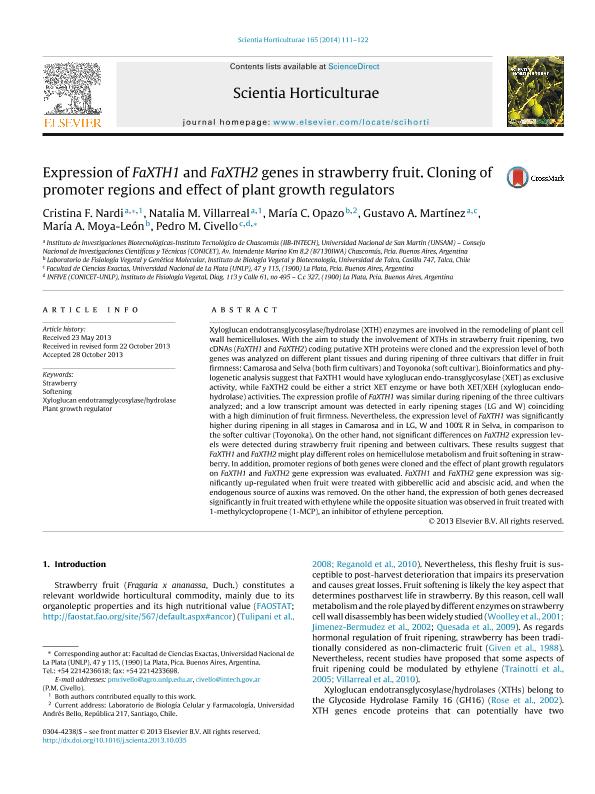Mostrar el registro sencillo del ítem
dc.contributor.author
Nardi, Cristina Fernanda

dc.contributor.author
Villarreal, Natalia Marina

dc.contributor.author
Opazo, Maria C
dc.contributor.author
Martinez, Gustavo Adolfo

dc.contributor.author
Moya León, Maria A.
dc.contributor.author
Civello, Pedro Marcos

dc.date.available
2017-09-21T20:06:15Z
dc.date.issued
2014-01-22
dc.identifier.citation
Nardi, Cristina Fernanda; Villarreal, Natalia Marina; Opazo, Maria C; Martinez, Gustavo Adolfo; Moya León, Maria A.; et al.; Expression of FaXTH1 and FaXTH2 genes in strawberry fruit. Cloning of promoter regions and effect of plant growth regulators; Elsevier Science; Scientia Horticulturae; 165; 22-1-2014; 111-122
dc.identifier.issn
0304-4238
dc.identifier.uri
http://hdl.handle.net/11336/24840
dc.description.abstract
Xyloglucan endotransglycosylase/hydrolase (XTH) enzymes are involved in the remodeling of plant cell wall hemicelluloses. With the aim to study the involvement of XTHs in strawberry fruit ripening, two cDNAs (FaXTH1 and FaXTH2) coding putative XTH proteins were cloned and the expression level of both genes was analyzed on different plant tissues and during ripening of three cultivars that differ in fruit firmness: Camarosa and Selva (both firm cultivars) and Toyonoka (soft cultivar). Bioinformatics and phylogenetic analysis suggest that FaXTH1 would have xyloglucan endo-transglycosylase (XET) as exclusive activity, while FaXTH2 could be either a strict XET enzyme or have both XET/XEH (xyloglucan endohydrolase) activities. The expression profile of FaXTH1 was similar during ripening of the three cultivars analyzed; and a low transcript amount was detected in early ripening stages (LG and W) coinciding with a high diminution of fruit firmness. Nevertheless, the expression level of FaXTH1 was significantly higher during ripening in all stages in Camarosa and in LG, W and 100% R in Selva, in comparison to the softer cultivar (Toyonoka). On the other hand, not significant differences on FaXTH2 expression levels were detected during strawberry fruit ripening and between cultivars. These results suggest that FaXTH1 and FaXTH2 might play different roles on hemicellulose metabolism and fruit softening in strawberry. In addition, promoter regions of both genes were cloned and the effect of plant growth regulators on FaXTH1 and FaXTH2 gene expression was evaluated. FaXTH1 and FaXTH2 gene expression was significantly up-regulated when fruit were treated with gibberellic acid and abscisic acid, and when the endogenous source of auxins was removed. On the other hand, the expression of both genes decreased significantly in fruit treated with ethylene while the opposite situation was observed in fruit treated with 1-methylcyclopropene (1-MCP), an inhibitor of ethylene perception
dc.format
application/pdf
dc.language.iso
eng
dc.publisher
Elsevier Science

dc.rights
info:eu-repo/semantics/openAccess
dc.rights.uri
https://creativecommons.org/licenses/by-nc-sa/2.5/ar/
dc.subject
Strawberry
dc.subject
Softening
dc.subject
Xyloglucan Endotransglycosylase/Hydrolase
dc.subject
Plant Growth Regulator
dc.title
Expression of FaXTH1 and FaXTH2 genes in strawberry fruit. Cloning of promoter regions and effect of plant growth regulators
dc.type
info:eu-repo/semantics/article
dc.type
info:ar-repo/semantics/artículo
dc.type
info:eu-repo/semantics/publishedVersion
dc.date.updated
2017-09-18T14:29:53Z
dc.journal.volume
165
dc.journal.pagination
111-122
dc.journal.pais
Países Bajos

dc.journal.ciudad
Amsterdam
dc.description.fil
Fil: Nardi, Cristina Fernanda. Consejo Nacional de Investigaciones Científicas y Técnicas. Centro Científico Tecnológico Conicet - La Plata. Instituto de Investigaciones Biotecnológicas. Instituto de Investigaciones Biotecnológicas "Dr. Raúl Alfonsín" (sede Chascomús). Universidad Nacional de San Martín. Instituto de Investigaciones Biotecnológicas. Instituto de Investigaciones Biotecnológicas "Dr. Raúl Alfonsín" (sede Chascomús); Argentina
dc.description.fil
Fil: Villarreal, Natalia Marina. Consejo Nacional de Investigaciones Científicas y Técnicas. Centro Científico Tecnológico Conicet - La Plata. Instituto de Investigaciones Biotecnológicas. Instituto de Investigaciones Biotecnológicas "Dr. Raúl Alfonsín" (sede Chascomús). Universidad Nacional de San Martín. Instituto de Investigaciones Biotecnológicas. Instituto de Investigaciones Biotecnológicas "Dr. Raúl Alfonsín" (sede Chascomús); Argentina
dc.description.fil
Fil: Opazo, Maria C. Universidad de Talca; Chile
dc.description.fil
Fil: Martinez, Gustavo Adolfo. Consejo Nacional de Investigaciones Científicas y Técnicas. Centro Científico Tecnológico Conicet - La Plata. Instituto de Investigaciones Biotecnológicas. Instituto de Investigaciones Biotecnológicas "Dr. Raúl Alfonsín" (sede Chascomús). Universidad Nacional de San Martín. Instituto de Investigaciones Biotecnológicas. Instituto de Investigaciones Biotecnológicas "Dr. Raúl Alfonsín" (sede Chascomús); Argentina. Universidad Nacional de La Plata. Fundación Ciencias Exactas; Argentina
dc.description.fil
Fil: Moya León, Maria A.. Universidad de Talca; Chile
dc.description.fil
Fil: Civello, Pedro Marcos. Consejo Nacional de Investigaciones Científicas y Técnicas. Centro Científico Tecnológico Conicet - La Plata. Instituto de Fisiología Vegetal. Universidad Nacional de La Plata. Facultad de Ciencias Naturales y Museo. Instituto de Fisiología Vegetal; Argentina. Universidad Nacional de La Plata. Fundación Ciencias Exactas; Argentina
dc.journal.title
Scientia Horticulturae

dc.relation.alternativeid
info:eu-repo/semantics/altIdentifier/doi/http://dx.doi.org/10.1016/j.scienta.2013.10.035
dc.relation.alternativeid
info:eu-repo/semantics/altIdentifier/url/http://www.sciencedirect.com/science/article/pii/S030442381300561X
Archivos asociados
